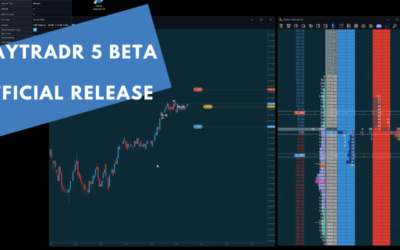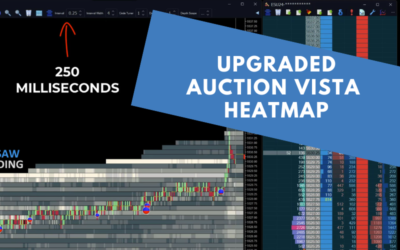Optimize Trading Tactics To Make Them More Effective
At the end of this post is a recording of the webinar John Slazas presented on 14th November.
Every trader has certain trading tactics they have acquired over the years that provide the basis of the method they use to trade the market. Although the applied approach may resonate and bring a high level of trust, the success ratio without a standardized Trade Plan and normalized Trade Strategy will undoubtedly lack consistency and not be sustainable. Applying Trade Tactics within the construct of a normalized Trade Strategy improves its effectiveness and can be optimized when executed within defined market structure and by incorporating dynamic order flow events.
John demonstrated the process of creating a systematic approach to trading and how trade tactics can be optimized by using Jigsaw’s JSServices integration:
- How standardizing a trading approach can make it more sustainable
- How using Jigsaw’s JSServices integration to normalize a trade strategy improves consistency
- How macro structure metrics and orderflow dynamics can optimize trade tactics effectiveness
Attendees gained insight into the steps needed to create a more systematic approach to trading and offered a free trial of a comprehensive set of analytics and applications that support that process. The video is at the end of this blog post.
Special Offer
John is offering $150 off a quarterly subscription to JSServices that includes a complimentary Personality Profile Assessment. There are 2 documents, the Peak Performance explains the entire Trade Plan Standardization process which is needed as the basis for creating the basis to optimize Trade Tactics and the other document is a quick overview of the Personality Profile with a link to take the Assessment. Go to http://www.jsservices.trade/ and select Request a Demo. In the “Referred by (required)” field they should type “webinar” to get the special offer to get the discount.
Personality Profile
A standardized trade plan is needed as a foundation to optimize trade tactics to make them more effective. Below is an overview of the attached documents which support this development.
peak-performance-tradeplan-development
TradePlan Standardization
The Standardization process begins by identifying a traders core strengths, motivations, expectations and risk tolerances. This intelligence provides insight into the best suited trading style and method to be used to create a Trade Plan profile that will serve as the basis in forming a sustainable trade program. The Trade Plan is standardized by conforming it to JSServices Analytics which unify the approach across all markets and asset classes.
Core Strength Assessment
The Core Strength Assessment provides trader’s with a cornerstone to create a trading foundation that is tailor made to suit ones personality, ability and resources resulting in a sustainable Trade Plan.
Personality Profile
Personality Assessment – Traders take a standardize personality profile, which when evaluated in an assessment creates the basis for developing a Trade Plan that leverages strengths and minimizes weaknesses.
Trade Plan Profile – Traders complete a profile worksheet which provides awareness to highlight the parts of a personality that will affect decision making then aligns these parts with core strengths to create a Trade Plan Profile
Video
FREE BONUS: Take a look into the decision-making process of professional traders with this video training series that helps you make smarter trading decisions. (Article continues below)
Order Flow itself is simply information. Just like charts, it can be used in a number of ways, some good and some bad. But let's first break down order flow into it's components so we all agree what we are talking about:
Order Executions/Tape Reading - This aspect is the real flow of orders. It's the information we see in Time & Sales, Footprint Charts, Cumulative Delta. It is looking at market orders, either as they execute or historically. I guess this is the "true order flow". Every trade is a buy and a sell. We look at market orders because we consider them to be more aggressive. When someone trades with a market orders, they are giving up a price to get an instant fill. Limit orders on the other hand just lazily sit there waiting for a market order to hit them. Often these are market makers with no directional conviction. So we see market orders as being more significant.
But we don't use these in isolation.
Volume Profile/Positions - The tape reading part helps us assess various things like momentum, traders getting stuck, balance of trade BUT the volume profile helps us understand where people are positioned and likely to get stopped out. I sometimes call this "Order Flew". It's important to know when trades will be "washed out" - for example - if we have a volume cluster on the S&P500 Futures and the market moves up 100 points and back down to it, it's unlikely short term traders on either side that were positioned there will still be there. But recent, nearby volume helps us assess areas of positions.
Market Depth - The bids and offers, the lazy passive orders waiting to be hit. This is part of the story but in terms of overall importance, I'd put it at around 20% at most. For example - if you return to the high of the day on any market, the offers will be quite large directly above the high. It means nothing at all. It's just a quirk of the market. It does not help you tell if a price will hold. On the other hand, if you see large depth and as we approach it, we see more added to the depth in front of that price, it means others are front running that depth and that is a useful bit of information.
This is the key - it is all just information. Just like price charts are information. When people look at Order Flow, they consider it to be a technique more than a set of information. They look for things like iceberg orders and decide to make a one rule trading system to fade every iceberg, For these people - yes, order flow is overrated because they are trying to ignore everything else going on in the markets and construct a trading system a chimp could execute.
For those looking to improve a decent trading approach, the best thing to focus on in Order Flow is momentum. Once you can read momentum you can:
- Avoid getting into positions when momentum is against you.
- Confirm trades are working after entry when momentum goes your way.
- Exit trades in profit when momentum fades.
That's perhaps the easiest way to use order flow because momentum is easier to read. It's about the market continuing to do what it's already doing. On the other hand, reading a turn in the market with order flow takes a higher level of skill and a little longer to learn.
Order flow can't put lipstick on a pig. It won't help you 'improve' something that doesn't work anyway, which is why whenever someone calls me, the first thing I ask is what they are currently doing and we discuss whether they need a reset or whether it will actually help.
When Jigsaw started back in 2011 - we were one of the first in the space and certainly had the best education. It was always going to attract the underbelly of the trading education/tools world and now we see stuff out there that is so complex but so impressive and futuristic that new traders are drawn to it like moths to a flame.
So here's my advice when looking at Order Flow
- Order Flow can't improve something that doesn't work.
- Order Flow can be used on it's own, without charts to enter and exit the market but you also have to be able to recognize different market states that need different/altered setups. There is nothing magical about this.
- Don't start jumping at shadows and take 50 trades an hour in your first week looking at Order Flow, be selective. It can be exciting to see cause and effect play out in front of you for the first time but don't overtrade.
- Do drills to learn how to read it before you trade it.
- Markets can only go up and down. Don't overcomplicate it. If you have too many Order Flow tools on your screen - you will not be able to make consistent decisions. Less is more.
- Take time to choose a market with a pace you like. Interest rates might send you to sleep, the DAX might give you a heart attack.
It is hard to see how a set of information could be overrated. It is true that some methods of presenting this information are better than others. It is also true that some people simply get on better with different tools (e.g. Footprint vs DOM).
There's a middle ground between complexity and simplicity that will leave you making consistent decisions where you improve over time. For those people, Order Flow will be way underrated because they will be the one's getting the most out of it.
Those that jump in with both feet on day one and those that have 100 different tools up, for those, it's a painful experience.
Keep it simple and manageable. Start with momentum reading and build from there. You will never look back.




0 Comments